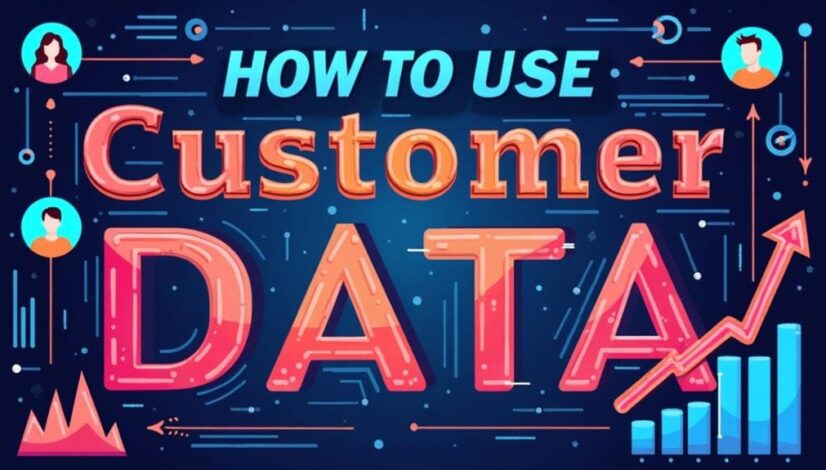How to Use Customer Data to Shape Your Marketing Strategy
To effectively use customer data in shaping your marketing strategy, begin by identifying and collecting relevant data types, such as demographics, behavioral patterns, and psychographics. Analyzing this data enables you to reveal trends and insights that inform audience segmentation, allowing for targeted marketing efforts. Personalization is key; it enhances engagement and conversion rates by tailoring messages and offers to specific consumer needs. Additionally, measuring campaign effectiveness through analytics tools provides a clear picture of performance. By continuously refining strategies based on data-driven feedback, businesses can foster loyalty and optimize marketing outcomes. Explore further to access the full potential of your customer data.
Key Takeaways
- Collect and analyze customer data through demographic, behavioral, psychographic, and geographic segmentation to understand and target your audience effectively.
- Utilize personalized marketing campaigns with targeted messaging and dynamic content to enhance customer engagement and conversions.
- Leverage data-driven insights from customer feedback and analytics to improve the customer experience and refine marketing strategies.
- Measure campaign effectiveness by tracking user interactions, engagement levels, and comparing results against industry standards to identify areas for improvement.
- Stay compliant with data privacy regulations by implementing robust security measures and ensuring transparency in data usage to build trust with customers.
Understanding Customer Data Types

In the domain of modern marketing, an in-depth understanding of customer data types is essential for crafting effective strategies that resonate with target audiences. Demographic analysis provides foundational insights by categorizing consumers based on age, gender, income, and geography. However, relying solely on demographics neglects the complexity of consumer behavior. Engaging with behavioral patterns allows marketers to track actions over time, revealing how customers interact with brands and informing future strategies.
Psychographic segmentation enhances this understanding by delving into customers' interests, values, and lifestyle choices. Leveraging this data through advanced data visualization techniques can illustrate trends and patterns, improving data integration across platforms.
Accuracy in data management is paramount; erroneous data can skew analyses and lead to misguided marketing decisions. Moreover, the principles of data privacy must be adhered to while collecting and analyzing customer information, ensuring that consumers feel secure and respected.
By harnessing predictive analytics, marketers can anticipate customer needs and enhance the customer journey, improving personalization. Finally, employing engagement metrics allows for continuous monitoring of strategy effectiveness, revealing areas requiring adjustment or enhancement.
In this intricate ecosystem of data-driven marketing, the fusion of diverse data types and methods not only amplifies understanding but also fosters deeper customer connections, ultimately empowering audiences with choice and freedom in a marketplace that increasingly respects their individual preferences.
Collecting Relevant Customer Data
Collecting relevant customer data is a critical component of developing an effective marketing strategy that aligns with consumer needs and preferences. To harness the power of data, businesses must identify appropriate data sources, such as surveys, social media interactions, and transactional histories. Employing diverse data collection methods enhances data accuracy, thereby increasing the reliability of insights derived from this information.
Before commencing data collection, it is imperative to prioritize ethical considerations and guarantee data privacy. This includes obtaining customer consent, which builds trust and fosters deeper relationships with your audience.
Establishing a clear framework for data storage is essential, as it directly impacts the data lifecycle management. Proper data storage guarantees compliance with regulations while facilitating data integration across various marketing platforms.
Utilizing effective survey strategies can lead to more meaningful data segmentation, allowing organizations to identify distinct customer groups and tailor their marketing efforts accordingly. In addition, data visualization techniques can transform complex datasets into easily digestible formats, enabling quick comprehension of key insights.
As businesses navigate the intricate landscape of customer data, maintaining a focus on ethical practices and customer rights will not only contribute to compliance but also position them as trustworthy entities within the market.
Ultimately, the cultivation of relevant customer data, grounded in transparency and respect for consumer autonomy, empowers brands to create targeted strategies that resonate with their audience, driving both engagement and loyalty.
Analyzing Trends and Insights

Analyzing trends and insights derived from customer data is essential for informing strategic marketing decisions that align with consumer behaviors and market dynamics. By meticulously examining behavioral patterns, businesses can identify what drives consumer engagement, leading to more effective marketing strategies.
For instance, tracking changes in purchasing behavior over time can illuminate preferences, guiding product offerings and promotional campaigns that resonate with a targeted audience.
Moreover, understanding market fluctuations is vital for adjusting marketing efforts in real-time. As external factors such as economic conditions and cultural trends shift, customer preferences inevitably evolve. Utilizing data analytics allows marketers to anticipate these changes and respond proactively.
By integrating analytics tools to monitor shifts in consumer sentiment, brands can pivot quickly, ensuring their strategies remain relevant and effective.
Additionally, identifying emerging trends within customer data facilitates innovation. Companies can leverage insights to create new products or enhance existing services tailored to evolving needs.
For example, if data reveals a growing preference for sustainable products, brands can adjust their inventories to meet this demand.
Segmenting Your Audience
Effective audience segmentation is a cornerstone of targeted marketing strategies, enabling businesses to tailor their messaging and offerings to specific consumer groups. By meticulously defining your target audience, you can optimize marketing effectiveness and resource allocation.
Employing various segmentation strategies such as demographic profiling, behavioral segmentation, psychographic insights, and geographic segmentation allows for a more nuanced understanding of market niches.
Demographic profiling forms a foundational layer by categorizing consumers based on age, gender, income, and education, which helps identify distinct customer personas.
Behavioral segmentation goes deeper into understanding how consumer actions—such as purchase history and product preferences—inform their motivations. This insight allows brands to capture and leverage changing behaviors, ultimately leading to more engaging interactions.
Incorporating psychographic insights enables marketers to explore the values, beliefs, and interests that drive consumer decisions. This approach not only supports the creation of robust customer personas but also facilitates the identification of emerging needs within market niches.
Geographic segmentation further enhances these efforts by contextualizing consumer preferences based on location, which can greatly influence purchasing behavior.
Ultimately, effective segmentation represents a powerful opportunity to connect meaningfully with myriads of individuals, achieving marketing freedom through specialization.
By adopting data-driven strategies that consider multiple facets of your audience, you can cultivate more impactful campaigns that resonate on a personal level, leading to increased brand loyalty and customer satisfaction.
Embrace the art of segmentation; the freedom to connect authentically lies within your reach.
Personalizing Marketing Campaigns

Once audience segments are meticulously defined, the focus shifts to personalizing marketing campaigns that resonate with these distinct groups. The power of targeted messaging lies in its potential to speak directly to customer needs and desires, thus fostering a connection that enhances brand loyalty and conversion rates. According to research by Epsilon, 80% of consumers are more likely to make a purchase when brands offer personalized experiences, emphasizing the necessity of tailoring communications to meet the unique characteristics of each segment.
Dynamic content plays a vital role in this personalization effort. By leveraging customer data, businesses can create responsive marketing materials that adapt in real-time to the audience's preferences and behaviors. This flexibility allows marketers to present tailored offers, product recommendations, or even content that speaks directly to the segment's interests. For example, an online retailer can showcase different items based on past purchases or browsing history, ensuring that the marketing message is not only relevant but also engaging.
Furthermore, the integration of advanced analytics can enhance the effectiveness of targeted messaging, allowing brands to refine their approach continuously. By evaluating engagement metrics, marketers can identify which messages resonate most, enabling them to optimize future campaigns based on empirical evidence.
The result is a cycle of improvement that drives higher engagement rates and sales conversions—ultimately empowering consumers through tailored experiences that consider their preferences and lifestyles. Personalizing marketing campaigns, consequently, is not merely an option; it is a strategic imperative that reveals the full potential of customer data.
Improving Customer Experience
Improving customer experience hinges on the effective use of personalization techniques, which can enhance engagement and satisfaction levels greatly.
By leveraging customer data, businesses can make informed decisions that tailor interactions to individual preferences, leading to increased loyalty and retention.
Data-driven insights not only refine marketing strategies but also create a seamless customer journey that meets expectations at every touchpoint.
Personalization Techniques
A substantial body of research indicates that personalization techniques greatly enhance customer experiences, leading to increased loyalty and revenue. By leveraging behavioral targeting, businesses can provide tailor-made solutions that resonate with individual preferences and needs. This strategic approach guarantees that marketing efforts are not only relevant but also highly effective, fostering a sense of connection with the consumer.
Dynamic content further amplifies this effect by adapting in real-time to user interactions, thereby enhancing customer engagement. For example, personalized email campaigns that change based on the recipient's past purchases or browsing behavior tend to yield higher open and conversion rates. According to data from Epsilon, personalized emails can generate up to six times higher transaction rates compared to non-personalized ones.
It's essential for marketers to embrace these advanced personalization techniques, as they not only cater to the desire for more relevant communication but also empower customers with a sense of autonomy in their interactions.
Data-Driven Decision Making
Data-driven decision making is increasingly recognized as a cornerstone for enhancing customer experience in today's competitive marketplace. By leveraging insights into customer behavior, businesses can tailor their offerings to meet the evolving needs and preferences of their clientele. This approach not only fosters customer loyalty but also provides a significant competitive edge.
Utilizing data visualization techniques allows organizations to distill complex data trends into understandable formats, making it easier for decision-makers to identify actionable insights. For instance, heat maps and customer journey graphs illustrate pain points in user experiences, while demographic and purchase data reveal potential areas for improvement.
Such clarity enables brands to adapt strategies in real-time, fostering a more engaging and meaningful customer interaction.
Moreover, data-driven insights empower companies to segment their audiences and create targeted campaigns that resonate deeply with specific groups. This leads to optimized marketing efforts and improved customer satisfaction as clients feel understood and valued.
Ultimately, an investment in extensive data analytics and visualization not only enhances operational efficiency but also revolutionizes the way businesses connect with customers, creating a dynamic ecosystem where personalized experiences thrive.
Measuring Campaign Effectiveness

Evaluating campaign effectiveness requires a systematic approach that integrates quantitative metrics and qualitative insights.
To truly understand the impact of your marketing efforts, it is essential to dissect performance benchmarks and campaign metrics. By leveraging robust analytical frameworks, you can identify not only what drove customer engagement but also how to improve future initiatives.
Here are key strategies to reflect on when measuring campaign effectiveness:
- Define Clear Objectives: Establish specific, measurable goals for what your campaign seeks to achieve. This could relate to conversions, brand awareness, or customer retention.
- Utilize Analytic Tools: Employ data analytics tools to track user interactions, assess traffic sources, and monitor engagement levels. These insights will provide a thorough view of your campaign's performance.
- Compare Against Industry Standards: Benchmark your results against industry standards to understand where you stand. This comparative analysis helps pinpoint strengths and areas needing improvement.
Utilizing Feedback for Growth
Harnessing customer feedback is a powerful catalyst for growth, providing invaluable insights that can shape marketing strategies effectively. By carefully analyzing customer sentiment, organizations can identify pain points and areas for improvement, enabling them to craft targeted marketing initiatives.
Feedback loops, which are systematic processes for collecting and integrating customer opinions, not only enhance product development but also foster a culture of continuous improvement within the company.
The integration of customer feedback into marketing strategy yields actionable data that reflects the voice of the consumer. For instance, surveys, social media interactions, and customer reviews serve as a treasure trove of information. Utilizing sentiment analysis tools can quantify customer feelings toward your brand, allowing marketers to make data-driven decisions that resonate more profoundly with their target audience.
Moreover, establishing robust feedback loops guarantees that customers feel heard and valued. By regularly engaging with consumers through various platforms, businesses can create a dynamic exchange, leading to enhanced loyalty and trust. This two-way communication empowers customers, reinforcing their sense of freedom to express thoughts and opinions without reservation.
Ultimately, leveraging feedback not only fine-tunes marketing messages but also aligns product offerings with customer expectations. In this era where consumer preferences rapidly evolve, prioritizing feedback is vital for brands that aspire to stay relevant and competitive.
As a result, organizations that commit to understanding and acting upon customer sentiment will not just survive but thrive in this data-driven marketing landscape.
Staying Compliant With Data Policies

In today's increasingly digitized marketplace, compliance with data policies has become a critical concern for organizations leveraging customer data in their marketing strategies. Compliance regulations are evolving rapidly, and the emphasis on data privacy, customer consent, and ethical considerations cannot be overstated. By adhering to these standards, companies not only mitigate legal risks but also enhance their reputations in the marketplace.
To effectively navigate the landscape of data compliance, businesses should prioritize:
- Understanding Legal Frameworks: Familiarize yourself with local and international regulations, such as the General Data Protection Regulation (GDPR) and the California Consumer Privacy Act (CCPA).
- Implementing Data Security Measures: Adopt robust security protocols that protect customer data from unauthorized access and breaches, guaranteeing that sensitive information is safeguarded.
- Regularly Updating Policies: Stay informed on policy updates and emerging compliance trends to adapt your strategy accordingly.
Furthermore, organizations must prioritize risk management strategies that incorporate regular audits and assessments of data handling practices.
These strategies not only help in maintaining compliance but also build customer trust, an invaluable currency in today's market. Striking a balance between effective marketing and compliance is essential; organizations must ascertain that they operate within the legal framework while pursuing proactive and innovative customer engagement approaches.
Ultimately, staying committed to compliance enhances sustainability and fosters a culture of responsibility that resonates with modern consumers.
Frequently Asked Questions
How Can I Ensure Data Accuracy Before Analysis?
Ensuring data accuracy before analysis is paramount for reliable insights.
Employ robust data validation techniques, such as cross-verification against trusted sources and consistency checks, to identify discrepancies early.
Coupled with effective data cleaning methods—like removing duplicates, correcting errors, and standardizing formats—you can greatly enhance the quality of your data.
This meticulous approach enables a data-driven decision-making process, fostering a more liberated and strategic use of analytics for organizational growth and innovation.
What Tools Can Help Streamline Customer Data Collection?
To streamline customer data collection, leveraging advanced analytics tools is essential.
Platforms such as Google Analytics, HubSpot, and Tableau facilitate efficient data gathering and real-time monitoring of customer interactions.
These tools not only enhance the accuracy of collected data but also allow deeper insights through intuitive visualizations.
How Often Should I Update My Audience Segments?
Updating audience segments should be a strategic decision based on audience behavior and changing market dynamics.
Regular segmentation frequency, ideally quarterly or bi-annually, allows for timely adjustments to reflect shifts in consumer preferences and engagement.
By analyzing data trends, marketers can refine their targeting efforts, enhancing engagement and conversion rates.
Implementing a proactive approach to updating audience segments empowers businesses to remain agile, maximizing their potential for reaching diverse consumer needs effectively.
What Types of Metrics Should I Track for Effectiveness?
To evaluate effectiveness, it is imperative to track key metrics such as conversion rates and customer feedback.
Conversion rates provide insight into how well your marketing initiatives are driving desired actions among your audience, while customer feedback offers qualitative data that highlights areas for improvement.
Analyzing these metrics will empower your business to adapt strategies, enhance customer satisfaction, and ultimately foster a more liberated connection between your brand and its audience.
How Do I Address Data Privacy Concerns Transparently?
Addressing data privacy concerns requires a commitment to data transparency that aligns with privacy regulations.
Clearly outline your data collection practices, specifying what information is collected, how it is used, and the rights customers have regarding their data.
Providing easy access to privacy policies fosters trust and empowers consumers to make informed choices.
Conclusion
The strategic integration of customer data into marketing frameworks can yield remarkable benefits and, conversely, significant pitfalls if mismanaged. While personalization enhances engagement and drives loyalty, a lack of proper analysis may result in misguided efforts and wasted resources. Balancing data utilization with compliance safeguards not only enriches customer experiences but also mitigates potential risks. Consequently, leveraging customer data represents both a transformative opportunity and a critical responsibility for organizations aiming to thrive in an increasingly data-driven marketplace.




